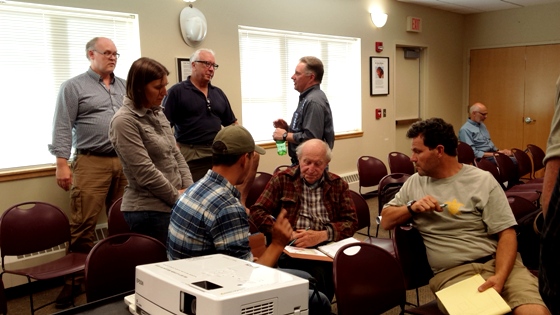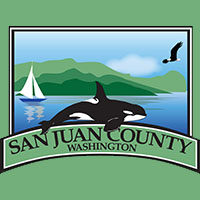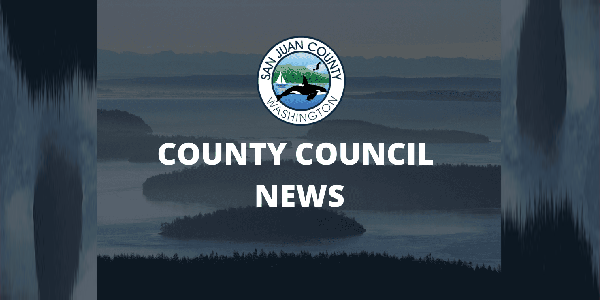–by Matthew Gilbert, Orcas Issues reporter–

Eastsound Planning Review Committee members, county staff and Orcas Island residents confer at Eastsound Planning Review Committee Meeting in 2016.
For all you policy wonks out there – as well as for anyone who cares about the future of our island paradise – the update of the County’s Comprehensive Plan is underway. The plan establishes policy guidelines through 2036 and is required to be updated every eight years.
Technical reports are nearly finished and planners are now seeking feedback from the general public. One hopes that the recent experience with the Port of Orcas for developing a 20-year Master Plan, in which public input had little to do with the actual plan put into place, won’t be repeated. Another cautionary note: the County Council’s recent decision (with the exception of Bill Watson) to do only “the minimum legally required” to bolster shoreline protections for our declining orca whale population despite local and statewide calls for stronger action.
The County’s process will be guided by the County Vision Statement (amended last June). It reflects 120 public comments to a series of drafts and is understandably broad in scope; the ultimate translation of those objectives remains open to discussion. Also influencing updates to the Plan are the following:
- Incorporating relevant changes in state law and the Growth Management Act.
- Responding to changes to current land use and population trends.
- Addressing local preferences and needs.
The update process technically began last January and the latest calendar shows final hearings scheduled for next summer. (To view current documents and stay abreast of new developments, visit the County Comp Plan website). The public input process is now underway, and following a workshop on Lopez, Planning Director Erika Shook, Planner Adam Zack, and Planning Manager Linda Kuller brought their presentation to Orcas on October 10th.
In framing the goals of the process, Shook called it a “playbook for the future. What will San Juan County look like in 20 years?” The purpose of this particular workshop was to generate preliminary feedback on general policies governing six specific areas:
- Land Use
- Housing
- Transportation
- Capital Facilities / Utilities
- Economic Development
- Water Resources
Phase I of the workshop used a technique that was admittedly “experimental”: electronic polling. Each of the approximately 30 participants were given a “clicker” with which to select a response to a series of policy options following a brief description of the issue being addressed (e.g., land use patterns, development constraints, road improvements, vacation rentals, tourism, and so on). Results for each question were then shown on a bar chart.
The results of the process turned out to be less important than de-bugging the process itself, though it’s worth mentioning (at least to Orcas readers!) that in response to a question about airport runways – larger planes/fewer trips per day vs. size limitations/more trips per day – everyone in the room chose the latter. Among the process issues raised were the lack of time to more fully explain the context of certain issues, the assumptions behind the policy choices provided, over-simplification of some of those choices, and the impacts of specific choices.
Phase II of the workshop had the room break out into smaller groups to provide more detailed feedback on how their feelings about certain topics (e.g., road widening, affordable housing) translated into map locations. Each group then reported out (Shook stayed for that session while Zack and Kuller bolted to the ferry) and several issues were raised that were not reflected in the Phase I process, including suggestions on accommodating renewable energy and the role of local agriculture.
As Kuller later explained, “Based on input from the Lopez and Orcas workshops, we have adjusted the workshop timing so we aren’t rushed. We’ll also request questions prior to polling. The information provided in the presentation has been improved and incorporates the answers to questions that have come up in earlier sessions. We’ll use the information received throughout this process to inform future public outreach events. We have also built in additional noticing methods (such as making sure that all meetings are posted on the general County Calendar and any other calendar available and making sure that we inform community groups that we have email addresses).
“Once all the workshops have been completed, we will release a summary report outlining the results of the individual workshops and summarizing overall input. These reports will be posted to our project webpage. We’ll incorporate additional on-line surveys and other interactive methods of public participation in future public outreach events related to the development of draft goals, policies, and land use maps. These drafts will be presented to the public for review and comment.”
Specific comments can be directed to the Planning Department via compplancomments@sanjuianco.com.
**If you are reading theOrcasonian for free, thank your fellow islanders. If you would like to support theOrcasonian CLICK HERE to set your modestly-priced, voluntary subscription. Otherwise, no worries; we’re happy to share with you.**









Thank you for reporting on this, Matthew. And thank you to Erika Shook for staying afterwards to hear our presentations and questions, and for these attempts to listen. Our job is to assure that the right questions are being asked.
I was heartened to see several young people there, but we need more youth participation: It’s your future. If the majority who show up are people who want unlimited growth and development, that’s what we’ll get. If you can’t show up, be sure to make specific written comment, addressed to council@sanjuanco.com and ask that your comment be kept in the record “in perpetuity” – this guarantees 7 years anyway.
We still have such a long way to go in getting representation for the Plan elements that always seem to get thrown under the bus – healthy environment (not the “minimum we have to do’ – that is a wrong-headed approach in these times!), rural character (including in our “UGAs”) and quality of life for the lowest common denominator – this would help. To do all this we need to be honest about carrying capacity and use realistic buildout numbers.